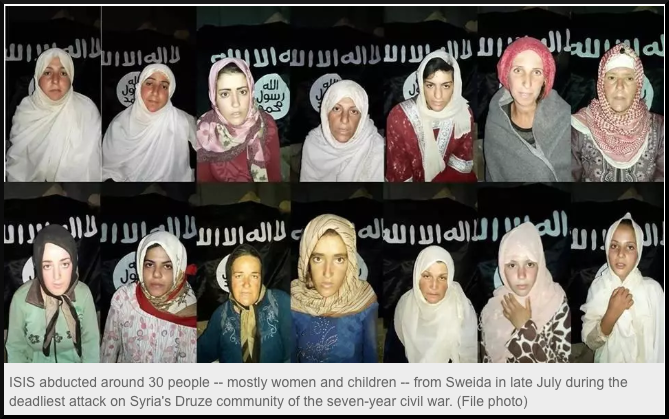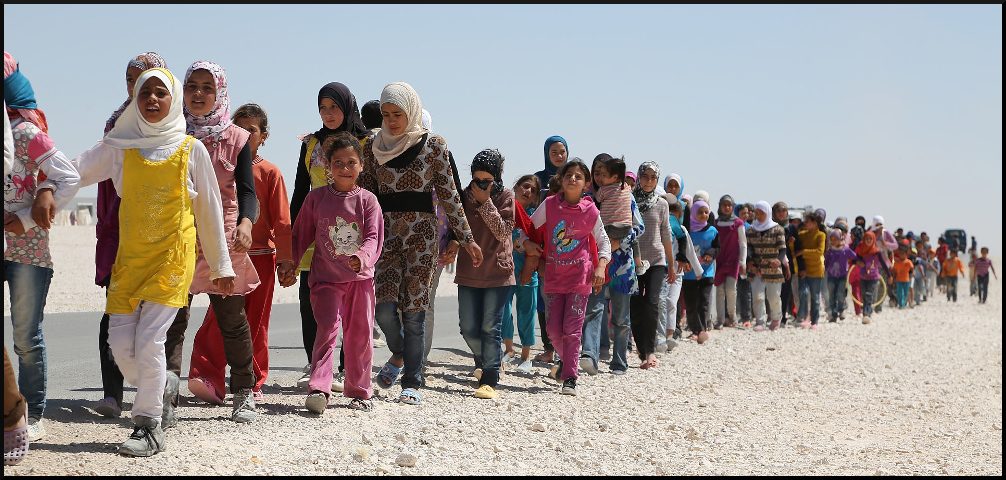Photo: Hundreds of refugees from the US-led coalition-controlled Rukban refugee camp bordering Jordan have traveled several hundred kilometers west to the Damascus suburbs seeking assistance from Syrian authorities. ~Sott.net
By Talal el-Atrache from Syria Comment – 8 Nov 2018
Throughout the Syrian war, the Southern Province of Sweida, in coordination with the Syrian army, had succeeded in protecting itself against the jihadist attacks on the province’s Western border with Deraa, and on the Eastern flank, adjacent to the Syrian Desert.
By the end of summer 2018, as the war seemed to reach an end in Southern Syria, the local paramilitary units were partially demobilized. The Syrian army units stationed in Sweida’s Desert were redeployed to the southwest of Deraa, where they joined the fight against an Isis enclave nestled at the foot of the Israeli controlled Golan Heights.
The demobilization was a fatal mistake. On July 25, at dawn, hundreds of Isis fighters emerged from the Eastern Desert. They carried out a coordinated attack marked by suicide bombings, shootings, and stabbings targeted mainly at the Eastern villages overlooking the Syrian Desert. The poorly armed local villagers, men and women, from 12 besieged villages fought bravely against the invaders, but six villages succumbed to the fundamentalist group as it carried out door-to-door massacres with the help of some local Bedouins.
The attack had two objectives. The first was to force the Syrian army to halt its offensive against the Isis enclave in Deraa. The second was for ISIS to provoking a massive exodus from the Druze Mountains.
Within less than two hours, hundreds of Druze fighters rushed to the targeted areas, killing more than 80 ISIS members. Dozens of Druze fighters from Mount Hermon and from the Damascene suburbs of Jaramana and Ashrafiet Sahnaya arrived that same day and joined the combat. The besieged areas, including the six ambushed villages, were liberated by the end of day, boosting the morale of the local population. More than 250 civilians and local Druze fighters lost their lives and another 250 people were injured, in what has become the bloodiest day for the province since the beginning of the war.
IS attack devastates Druze community in Southern Syria
Over the next few days, the army dispatched hundreds of soldiers and armored units, before launching a major counterattack in the Eastern Desert. By September,ISIS had lost more than 3000 square kilometers of land, and became completely encircled in al-Safa hills, a 250 square kilometer volcano in the middle of the desert east of Sweida. ISIS lost the Sweida battle but managed to capture 31 Druze hostages: 20 women and 11 children.
The local fighters found and rescued a woman who had managed to escape in the desert, while a second woman, shot in the head by the fundamentalist group, died.

For the next three months, the hostage issue became the major political, social and humanitarian concern in the Province of Sweida. ISIS conditioned the release of the abductees to the withdrawal of the Syrian army from the Eastern Desert, the neutrality of the Druze, the release ofISIS fighters and their relatives, and the payment of ransom. Damascus and the Druze delegation in charge of the hostage issue systematically rejected ISIS’ conditions, as they would have put the Druze Mountains in harm’s way and strengthened the fundamentalist group. As a result, ISIS killed two of 29 Druze hostages. Muhannad Abou Ammar, a 19 year old university student, was beheaded on August 1.
An older lady, Tharwat Abou Ammar, was shot on October 1. Another 65 year old captive died in custody. The video of the beheading and the pictures of Tharwat’s body covered in blood, published online by ISIS, angered the local population. They were aimed at putting pressure on the government.
On October 19, six Druze hostages were liberated in exchange for the release of 17 women (ISIS relatives/wives) held by the Syrian government, as well as a dozen Bedouin captives that had been kidnapped by some local Druze fighters in the aftermath of the July 25 attacks.
This was the first part of a negotiated agreement between Damascus and ISIS that also included a ceasefire in the Eastern Desert of Sweida, where the Syrian army has been fighting ISIS for the last three months with the help of Russian air force. According to some estimates, between 800 and 1000 ISIS fighters are now surrounded in the Safa volcanic field in the desert.
However, the truce collapsed on November 3 in addition to the second part of the deal that stipulated the liberation of seven Druze women and three children in exchange for the release of 35 ISIS relatives. The group demanded the release of 35 fighters from government custody, but was met with rejection since the initial deal only included civilians.
ISIS has had recent military success in Hajin near the Euphrates city of Deir ez-Zor, where it has killed some 327, US-backed fighters belonging to the Kurdish-led Syrian Democratic Forces since the beginning of the military operation there in September. ISIS has regained self-confidence and launched several assaults from the Safa Volcano, before being quickly rebuffed. On November 5, the Syrian army started deploying considerable reinforcements around the volcano, which consists of a plateau of black rocky hills where ISIS has not only been able to successfully resist for more than a month, but even launch deadly attacks against Syrian troops, killing more than 400 Syrian soldiers in the last three months. The Fourth Army Division (one of the toughest) and the Fifth Corps (advised by Russian officers) have deployed alongside Hezbollah units and the Palestine Liberation Army for the upcoming battle against ISIS. The impressive military buildup intimidated ISIS and forced the group to renegotiate.
On November 8, Syrian State media said that the government troops have freed all remaining Druze hostages kidnapped by ISIS. The army’s operation occurred in a remote area Northeast of Palmyra. However, some analysts believe that the liberation of the women and children was part of a prisoner’s deal exchange.
Meanwhile, the Syrian army launched a new assault against Isis on Thursday in the Safa hills. According to a member of the Druze delegation in charge of the hostage issue, there have been a few disagreements between the Americans and the Russians who were assisting the Syrians in the negotiations with ISIS. The Russians wanted to transfer all ISIS fighters from the Safa Volcano to the north of the Province of Hama, a region currently controlled by Hay’at Tahrir al-Sham (ex-Nusra, affiliated to al-Qaeda), while the Americans wanted to gather them in the Hajin region.
The refusal of Washington to cooperate with the Syrians and the Russians in the battle against ISIS has left a hole through which ISIS has been able to operate. The Americans have forbidden the Syrian army from penetrating within a 55 km radius buffer zone surrounding their military base in al-Tanf, 120 km east of the Safa Volcano. This base sits on the strategic Damascus-Baghdad highway. Damascus has declared this buffer zone problematic as it is preventing the Syrian army from cleaning up the area. The government believes the buffer zone is being used by Isis to move its troops undercover between Northern and Southern Syria, and between Syria and Iraq.
In Northern Syria, the US-backed Syrian Democratic Forces (SDF) have halted their military campaign against Isis after suffering heavy losses in the Hajin area in the Euphrates and following clashes against Turkish forces in Northern Syria. The Kurds, who lead the SDF, are focused on their struggle against the Turkish army after President Erdogan announced his intention to eradicate the SDF.
This leaves ISIS with enough room for maneuver to regain influence either in the Euphrates or along the Syrian-Iraqi border. The United States’ refusal to cooperate with the Russian and the Syrian armies might be counterproductive with the absence of troops on the ground capable of eradicating Isis.
Damascus also accuses Washington of training Isis fighters converted to moderate rebels, such as the Pentagon-backed Jaysh Maghawir al Thawra. The Syrian government is asking Washington to either contribute to its anti-Isis campaign in the Syrian Desert, or leave the area and let the Syrian army clean up the desert all the way to the Iraqi border.
On October 29, Syria’s foreign minister Walid al-Moallem declared that
“under the pretext of supporting Syrian Kurds, the U.S. has established bases in the North of Syria and a base in al-Tanf in the South, which are in reality used to reorganize ISIS terrorists to fight the Syrian Arab Army (…). What for? Because they want to prolong the Syrian crisis in Israel’s interests”.
US officials have declared that al-Tanf base serves as a launching pad for counter ISIS operations, even though the US coalition has never been involved in any effort to eradicate ISIS to the south of the Euphrates Valley, such as when ISIS invaded Palmyra, the suburbs of Damascus, and the Province of Sweida.
Washington maintains its base in Tanf as leverage in any future negotiations with the Russians. Its strategic goal is to stop Iran from establishing an East-West land corridor stretching from Tehran to Beirut that serves as an arms supply route to Hezbollah.
After the Syrian army and the Iraqi Popular Mobilization Units cleaned ISIS out of most of the desert, the US base in al-Tanf is becoming obsolete as an anti-ISIS tool. Sooner or later, Washington’s choice of maintaining Tanf will risk helping ISIS, rather than hurting it.
Talal el-Atrache can be reached on Twitter – @TalalElAtrache and on Facebook
